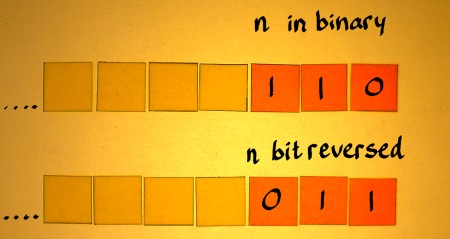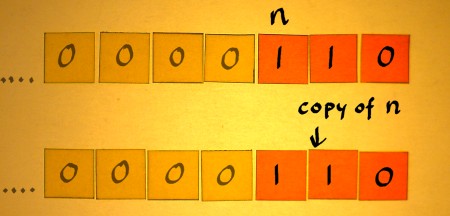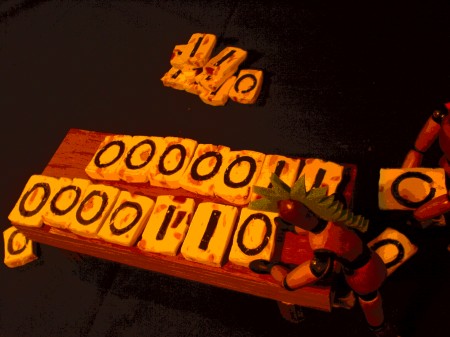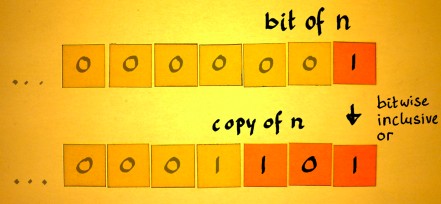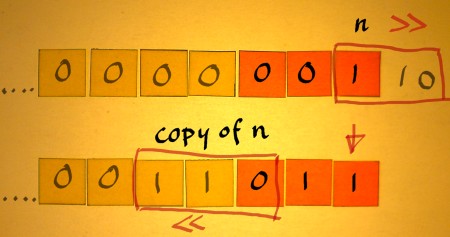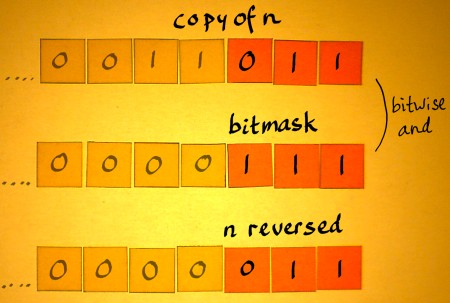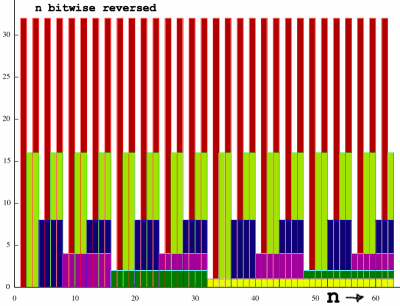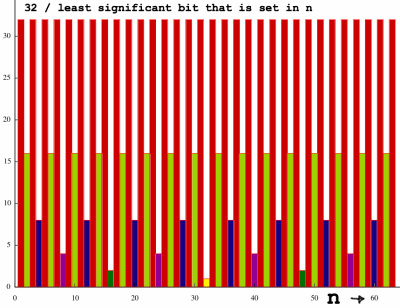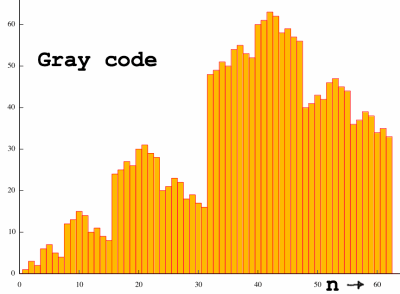Bit Reversal and Permutation
for Radix 2
In order to use the FFT schemes of the preceding pages, I need a
method for bitreversed permutation of the output arrays. Although
bitreversal is
generally considered a rather trivial aspect, I find it more
complicated than the FFT proper. In every FFT stage, the array entries
are intertwined in a systematical way, the pattern of which is quite
clear. But in the decimated end result, things appear shuffled beyond
comprehension. To unravel, you would not want to spend so many
iterations as in the whole FFT, like the naivest bit-reversed
permutation methods
do. More efficient methods tend to be rather enigmatic however.
On this page I want to
develop a visual sense of bit-patterns and ways to manipulate these. I
will
start from scratch. First find a routine to reverse the bitpattern of
one
integer. Then figure out a way of swapping the relevant
components within an array of length 2n.

|
Here is an example of a bit-reverse ordered output array
like it
could result from an FFT routine. The figure is copied from the page Phase
Decomposition, where I illustrated how repeated downsampling
shuffles the
entries in an array. It needs reorganisation before it makes sense
as being harmonics within a spectrum.
Let us take one example pair of entries that must be swapped.
Harmonic
number 6 is at the location where 3 should be, and 3 is where 6 belongs.
|
Below I have expanded both entries as binary numbers. So we are
looking at individual bits now. An integer datatype can
have 32 bits for
example, but here we would need only three of these.
General-purpose CPU's have no bit-reversal instruction, as far as I
know. Anyway there is no ANSI C operator to addres such an
instruction if it would exist. It would be so convenient if you could
just write
something like n ><= 3, to do the above sketched bit reversal.
Instead, we have to write a loop to reverse the bits in one
integer
number. Let us do it then.
To start, we store a copy of n in a
separate variable.
The bit-pattern of n must be shifted right one position, and it's
least
significant bit falls off.
At the same time, copy-of-n is shifted left
by one position. The vacant positions in n and copy-of-n are filled
with zero's.
It seems that the bit-reverse of n is already found. But that is
coincidence. We must continue systematically till all is
done.
We will now scan the least significant bit of the shifted n. That is
the second-least significant bit of the original. The scanning can be
done by a
bitwise-and operation. The unsigned integer value 1 masks everything
but the LSB.
This bit-of-n is then transferred to copy-of-n by inclusive
bitwise-or.
This works because copy-of-n always has a shifted-in zero at that
position. It takes the true value when bit-of-n is one, or remains zero
when the bit-of-n is zero.
The series of operations is repeated:
shift n one position right,
shift copy-of-n one position left,
give the LSB of n to copy-of-n.
After two iterations we have the LSB of the original three-bit n at
the MSB position of our copy-of-n. The loop of operations should end
here. But one thing remains to be done after that. The variable
copy-of-n has now decimal value 27. A last
bitwise-and operation is required to mask everything but the three
least significant bits that we use. The mask has value 7, which is N-1.
The result of this masking is that we finally have the bitpattern
011.
Notice that the count of iterations is one less than the count of
bits used for the values, because the LSB of n is the most significant
relevant bit in copy-of-n. Here we have the above sketched
bit-reversal
written as a C function:
|
unsigned int bitrev(unsigned int n, unsigned int bits)
{
unsigned int i, nrev; // nrev will store
the bit-reversed pattern
N = 1<<bits;
// find N: shift left 1 by the number of bits
nrev = n;
for(i=1; i<bits; i++)
{
n >>= 1;
nrev <<= 1;
nrev |= n & 1; //
give LSB of n to nrev
}
nrev &= N-1;
// clear all bits more significant than N-1
return nrev;
}
|
This loop could perform redundant iterations.
Imagine you have N=1024 which uses 10 bits, and do a bitreversal for
n=3 which turns bit pattern 0000000011 into 1100000000. After one
iteration you already have the set bits, but 8 more iterations will
follow. From the page 'Bit
Twiddling Hacks' by Sean Eron Anderson I learnt a modification to
avoid that redundancy. The loop can end when the shifted n has become
zero.
|
// modification of the preceding code
unsigned int bitrev(unsigned int n, unsigned int bits)
{
unsigned int nrev, N,;
unsigned int count;
N = 1<<bits;
count = bits-1; // initialize
the count variable
nrev = n;
for(n>>=1; n; n>>=1)
{
nrev <<= 1;
nrev |= n & 1;
count--;
}
nrev <<= count;
nrev &= N - 1;
return nrev;
}
|
With this code, the loop will end as soon as all high bits of n are
shifted out, and nrev receives a compensating shift after the loop end.
Later I understood that this will save only one iteration on average.
But never mind, we need a count
variable of some sort anyway.
So far we have code to compute a bit-reversed version
of only one integer. To visually check what happens to bitpatterns, I
have plotted the indexes 0 till 63 with their bits separately shown.
Here is the plot for n with the bits in their orignal order:
Below is a plot of the indexes with their bitpatterns reversed. For
example:
at index 000001, 100000 is plotted with it's individual bits
at index 110110, 011011 is plotted with it's individual bits
All the bits representing decimal 1 are now regrouped in the second
half of the plot. So all odd numbers are in that part. All bits
representing 32 are now spread evenly over the range. Etcetera.
Now we are going to reorganise an array according
to the bit-reversed indexes of
the components. That means swapping the contents of pairs with
bit-mirrored index,
if we want to recycle the array x[n]. While doing this, we should avoid
swapping content of entries on the identity diagonal (optional), and
avoid swapping content
twice (obligatory).
Let us take a look at the bit-reversed permutation matrix for N=8.
Four
entries
are on the identity diagonal, and we would prefer to skip these. Only
two pairs have to be swapped. x[1] with x[4] and x[3] with x[6].
Iterating over n, how do we decide whether to swap contents or not?
Well....
if n=nrev we have an identity, and we can skip the swapping. And if
n>nrev we will skip as well. Then we are sure that a pair is only
swapped once. For this to work, we have to compute all nrev, even for
the cases where we do not take action. Redundancy again. So be it. Let
us for the moment
just check whether a test routine will give correct output.
We need a loop iterating over n, and within that, a loop which
computes nrev. A conditional check will tell whether the
swap shall be performed or not.
|
/****** radix 2 bit-reversed-permutation test routine for N =
32
**********/
// .... this code goes in main
unsigned int N = 32, bits = 5; // array
length and number of bits
used
unsigned int x[32];
// test array
unsigned int n;
// index
unsigned int nforward, nreversed;
unsigned int count;
unsigned int temp;
// to store x[n] during swap
for(n=0; n<N; n++)
// fill the test array
{
x[n] = n;
}
for(n=1; n<N-1; n++)
// reorganise array x[n] in bit-reversed order
{
nreversed = n;
count = bits-1;
for(nforward=n>>1; nforward;
nforward>>=1)
{
nreversed <<= 1;
nreversed |= nforward &
1; // give LSB of nforward to nreversed
count--;
}
nreversed <<=count;
// compensation for missed iterations
nreversed &= N-1;
// clear all bits more significant than N-1
if(n<nreversed)
// swap condition
{
temp = x[n];
x[n] = x[nreversed];
x[nreversed] = temp;
}
}
// ......print the values of x[n] and x[nrev] to stdout for
check
|
I have checked that this code does the job. It may be utterly
inefficient, but at least I now have a basic understanding of
bit-reversed permutation. I just needed to go through this, before
checking
more advanced methods.
While staring at the bit-reversal matrices (I
have bigger ones that
do not fit on this page) I stumbled upon the 'not-identity-diagonal'.
It is perpendicular to the identity diagonal, and the column index is
the bitwise negation of the row index. All bit-reversed pairs seem to
be mirrored over
this not-I diagonal. Actually they are 180 degree rotations within the
matrix. That means, once you have a bitreversed pair it is
easy to identify the corresponding bit-wise-not pair that must be
swapped as well.
Straightforward exploitation of this symmetry could save half of the
iterations and
bit-reversal computations. The illustration below shows where the
bitreversed values and the bitwise negated values are located for
n<nrev and n<~nrev. Iterating over n till only N/2 will suffice
to compute the swaps for the whole matrix. There is one condition
however: no entries
should be precisely on the not-I-diagonal. They would be
swapped twice if they are included.
I wrote code for this, but it turned out that it only works for N
being
an odd power of 2. For an even power, some entries are on the
not-I-diagonal apparently. I was disappointed with the keen yet
inconvenient modification.
Still, it was a stepping stone to a more fruitful
reorganisation of the loop. After gazing at my permutation matrices a
couple
more times, I finally perceived the decisive pattern. The
lower-left and
upper-right quarters are coupled, while the upper-left and lower-right
quarters are mirrored. They ask for separate
treatment.
The upper left quarter entries must be checked against double
swapping as the bitmirrored pairs are within the region itself. Furter,
the identities are here. But then, once a bitmirrored pair is found and
checked, the bitwise negation of it can be done simultaneously, thereby
covering the lower right quarter.
The lower left quarter has it's bitreversed counterparts all in the
upper right quarter and never in it's own region. These entries can be
swapped unconditionally, since it happens to be the case that all the
lower left entries have n=odd.
Further, it is very easy to create an odd bitmirrored pair from an even
pair or vice versa. Therefore, we only have to find half of the
bitreversed pairs inbetween n=0 and n=N/2. That means, N/4 iterations
over the outer loop will suffice, N/4 bitreversal computations, and N/4
conditional checks. Now we are getting somewhere.
Computing bitwise-not of n can be done in C with ~n but it
must be masked by bitwise-and: (~n)&(N-1). It is also N-1-n (for N
being a power of 2), and
n^(N-1) which is an exclusive-or.
|
/****** radix 2 bit-reversed-permutation test routine for N =
32
**********/
// .... this code goes in main
unsigned int N = 32, bits = 5;
unsigned int NMIN1 = N-1;
unsigned int x[32];
// test array
unsigned int n;
// index
unsigned int count;
unsigned int nforward, nreversed;
unsigned int notn, notnreversed; // for bitwise negated
values
unsigned int temp;
// to store x[n] during swap
for(n=0; n<N; n++)
// fill the test
array
{
x[n] = n;
}
for(n=0; n<N>>1; n++) // only N/4
iterations, extra increment within loop
{
count = bits-1;
nreversed = n;
for(nforward=n>>1; nforward;
nforward>>=1) // reverses the bit-pattern of n
{
nreversed <<= 1;
nreversed |= nforward &
1; // give LSB of nforward to nreversed
count--;
}
nreversed <<=
count;
// compensation for skipped iterations
nreversed &= NMIN1;
// cut off all bits more significant than N-1
if(n<nreversed)
// for even n, swap conditionally
{
temp = x[n];
x[n] = x[nreversed];
x[nreversed] = temp;
notn = NMIN1 ^ n;
//
compute bitwise negations
notnreversed = NMIN1 ^ nreversed;
temp = x[notn];
x[notn] = x[notnreversed];
x[notnreversed] = temp;
}
// odd n and nreversed can be swapped unconditionally
n++;
// attention, extra increment!
nreversed |=
N>>1;
// set
highest bit in nreversed
temp = x[n];
x[n] = x[nreversed];
x[nreversed] = temp;
}
// end of the bitreversed permutation loop
// ......print the values of x[n] and x[nrev] to stdout for
check
|
Of this I have a decrementing version as well:
|
/****** radix 2 bit-reversed-permutation test routine for N =
32
**********/
// .... this code goes in main
unsigned int N = 32, bits = 5;
unsigned int NMIN1 = N-1;
unsigned int x[32];
// test array
unsigned int n;
// index
unsigned int count;
unsigned int nforward, nreversed;
unsigned int nodd, noddrev;
// for odd or bitwise negated
values
unsigned int temp;
// to store x[n] during swap
for(n=0; n<N; n++)
// fill the test
array
{
x[n] = n;
}
for(n=N>>1; n; )
// permutation loop, only N/4 iterations
{
n -= 2;
// decrement at unusual
place
nreversed = n;
count = bits-3;
// bitreversal loop now optimized for n=even
for(nforward=n>>2; nforward;
nforward>>=1) // reverses the bit-pattern of n
{
nreversed |= nforward &
1; // give LSB of nforward to nreversed
nreversed <<= 1;
// notice: order of
operations has changed
count--;
}
nreversed <<=
count;
// compensation for skipped iterations
nreversed &= NMIN1>>1;
// cut off all bits more significant than (N/2)-1
if(n<nreversed)
{
temp = x[n];
x[n] = x[nreversed];
x[nreversed] = temp;
nodd = NMIN1 ^ n;
noddrev = NMIN1 ^ nreversed;
temp = x[nodd];
x[nodd] = x[noddrev];
x[noddrev] = temp;
}
// odd n and nreversed can be swapped unconditionally
nodd = n | 1;
noddrev |= N>>1; // set
highest bit in nreversed
temp = x[nodd];
x[nodd] = x[noddrev];
x[noddrev] = temp;
}
// end of the bitreversed permutation loop
// ......print the values of x[n] and x[nrev] to stdout for
check
|
This modification speeds up the routine by a factor two, according
to time profiler results. I would think there is still more
gain possible.
Generally, a permutation routine would compute the bitreversed
values as
a
running sum, rather than starting from scratch in every iteration over
the outer loop. The
result can be updated with helper variables of some sort.
Unfortunately, the inner
mechanism of such code is hard to follow.
It would be more elegant to decouple the bit-mirrored pairs from the
loop index, and
compute both as running sums in a symmetric
fashion. The beautifullest algorithm that I have seen so far, does
exactly this. It is invented and published by Jennifer E. Elaan. See:
http://caladan.nanosoft.ca/index.php.
At the heart of Jennifer's technique is a Gray code generator. That
is supercool! The trigger for such a generator is hidden within a
natural number
sequence. Below I have plotted the pattern of the trigger or toggle for
N=64. Every value
is a pure power of two. This universal pattern can be extracted in
various ways. Illustrations of bit-patterns and extraction are on the
page Bitwise&Poundfoolish.
When N/2
is divided by the values in the plot above, you get the bit-reversed
values, as plotted below. It is a multiplicative
reflection.
Using these patterns you can toggle-switch bits of variables
initialized at zero, one at a time.
That is done by exclusive-or. Then you get a Gray code sequence and
it's bit-reversed version. A Gray code sequence plotted looks like this:
It looks freaky. But now watch the pattern of it's individual bits
plotted, like it was done earlier for a natural sequence:
And here is the Gray code with it's bit-patterns reversed:
Despite the differences between Gray code and the 'powers-of-two'
binary sequence, there is also a striking resemblance. The bits
appear in blocks of sizes proportional to their value. For several
reasons, both sequences work equally well in my odd-nodd-skippy
permutation structure that was described earlier.
Bitmirrored pairs can now be computed as running sums with help of a
loop that counts trailing zero's, a count which coincides with the base
2 logarithms of the 'toggle' pattern values. Iterating over a natural
index sequence i, I add an extra shift in the reconstructions to derive
even values of the forward variable exclusively. The initialisation of
forward and reversed is
adapted to the decrementing direction of the loop.
|
void bitrev(double *real, unsigned int logN)
{
unsigned int i, forward, rev, zeros;
unsigned int nodd,
noddrev; // to hold bitwise
negated or odd values
unsigned int N, halfn, quartn, nmin1;
double temp;
N = 1<<logN;
halfn =
N>>1;
// frequently used 'constants'
quartn = N>>2;
nmin1 = N-1;
forward = halfn;
// variable initialisations
rev = 1;
for(i=quartn; i; i--) // start of
bitreversed permutation loop, N/4 iterations
{
// Gray code generator for even values:
nodd =
~i;
// counting ones is easier
for(zeros=0; nodd&1; zeros++) nodd
>>= 1; // find trailing zero's in i
forward ^= 2 << zeros;
// toggle one bit of forward
rev ^= quartn >>
zeros;
// toggle one bit of reversed
|
if(forward<rev)
//
swap even and ~even conditionally
{
temp = real[forward];
real[forward] = real[rev];
real[rev] = temp;
nodd = nmin1 ^
forward; // compute
the bitwise negations
noddrev =
nmin1 ^ rev;
temp =
real[nodd];
// swap bitwise-negated pairs
real[nodd] =
real[noddrev];
real[noddrev]
= temp;
}
nodd = forward ^
1;
// compute the odd values from the even
noddrev = rev ^ halfn;
temp =
real[nodd];
// swap odd unconditionally
real[nodd] = real[noddrev];
real[noddrev] = temp;
}
// end of the bitreverse permutation loop
}
// end of bitrev function
|
Another factor 1.5 speed gain is the result of inserting Jennifer's
method. It works because there are only N-1 trailing
zero's over N indexes, which means 1 zero on average per index.
A zero's-counting-loop is therefore not quite so demanding as a loop
that reverses a whole bitpattern.
For some architectures, instructions are available for counting
trailing and leading zero's. Major compilers have C extensions, giving
access to such instructions. GNU has __builtin_ctz() for example. It
should be faster theoretically, or not? I have checked that the
function is expanded inline and it accesses Intel's bsfl instruction.
But for some reason, I have no profit from it.
After all these bitwise exercises, I got more confident and finally
grasped how the more traditional update of the bitreversed index works.
You could say that it counts and toggles 'leading ones' in the reversed
index, parallel to the flipping of 'trailing ones' in an incremented
forward index. And instead of shifting the index when counting, the
toggle variable is shifted rightward. The toggle can also be used as a
bitmask. I have adapted this method to my particular iteration scheme,
and it works just as fine:
|
void bitrev(double *real, unsigned int logN)
{
unsigned int i, forward, rev, toggle;
unsigned int nodd,
noddrev;
// to hold bitwise
negated or odd values
unsigned int N, halfn, quartn, nmin1;
double temp;
N = 1<<logN;
halfn =
N>>1;
// frequently used 'constants'
quartn = N>>2;
nmin1 = N-1;
forward = halfn;
// variable initialisations
rev = 1;
while(forward)
// start of
bitreversed permutation loop, N/4 iterations
{
// adaptation of the traditional bitreverse
update method
forward -= 2;
toggle = quartN;
// reset the toggle
in every iteration
rev ^= toggle;
//
toggle one bit in reversed unconditionally
while(rev&toggle)
// check if more bits in
reversed must be toggled
{
toggle >>= 1;
rev ^=
toggle;
}
|
if(forward<rev)
//
swap even and ~even conditionally
{
temp = real[forward];
real[forward] = real[rev];
real[rev] = temp;
nodd = nmin1 ^
forward; // compute
the bitwise negations
noddrev =
nmin1 ^ rev;
temp =
real[nodd];
// swap bitwise-negated pairs
real[nodd] =
real[noddrev];
real[noddrev]
= temp;
}
nodd = forward ^
1;
// compute the odd values from the even
noddrev = rev ^ halfn;
temp =
real[nodd];
// swap odd unconditionally
real[nodd] = real[noddrev];
real[noddrev] = temp;
}
// end of the bitreverse permutation loop
}
// end of bitrev function
|
In practical applications the bitreverse permutation will be used
for complex data. For now, I am working with separate real and
imaginary arrays. (I will switch to a complex datatype later.) In order
to keep code transparent, I have a swap
function, defined static inline.
static inline void swap(unsigned int forward, unsigned int rev, double
*real, double *im)
{
double temp;
temp = real[forward];
real[forward] = real[rev];
real[rev] = temp;
temp = im[forward];
im[forward] = im[rev];
im[rev] = temp;
}
void complexbitrev(double *real, double *im, unsigned int logN)
{
unsigned int i, forward, rev, zeros;
unsigned int nodd,
noddrev; // to hold bitwise
negated or odd values
unsigned int halfn, quartn, nmin1;
N = 1<<logN;
halfn =
N>>1;
// frequently used 'constants'
quartn = N>>2;
nmin1 = N-1;
forward = halfn;
// variable initialisations
rev = 1;
for(i=quartn; i; i--) // start of
bitreversed permutation loop, N/4 iterations
{
// Gray code generator for even values:
nodd =
~i;
// counting ones is easier
for(zeros=0; nodd&1; zeros++) nodd
>>= 1; // find trailing zero's in i
forward ^= 2 << zeros;
// toggle one bit of forward
rev ^= quartn >>
zeros;
// toggle one bit of rev
|
if(forward<rev)
//
swap even and ~even conditionally
{
swap(forward, rev, real, im);
nodd = nmin1 ^
forward;
// compute
the bitwise negations
noddrev =
nmin1 ^ rev;
swap(nodd,
noddrev, real, im); // swap
bitwise-negated pairs
}
nodd = forward ^
1;
// compute the odd
values from the even
noddrev = rev ^ halfn;
swap(nodd, noddrev, real,
im); // swap odd
unconditionally
}
// end of the bitreverse permutation loop
}
// end of complexbitrev function
|
While optimizing the bitreversal, memory access becomes more and
more the factor determining processing time. After all, these samples
have to be swapped no matter how. I can
bitreverse-sort one million real-and-imaginary arrays of
length N=1024 in some 6 seconds, on an Intel core2duo 2 GHz. That is
about
6 microseconds per vector pair. That will
do for the moment. I must quit this
topic now. In the time that I have spent on it I could have done
a zillion times zillion bitreversals with whatever wasteful routine.
At last. I can add bit-reversed sorting to my FFT routines
and have intelligible output from it. I will do some plots on an
upcoming
page. It is cool to finally have real and imaginary output plotted.
Regular analysers show amplitudes or decibels, that is fine for audio
engineers, but I want to see complex numbers.

